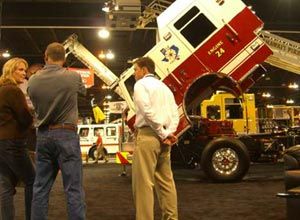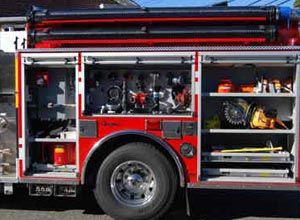| Editor’s note: There are numerous factors involved in selecting new fire trucks – and many of them are highlighted in Bob Vaccaro’s Apparatus Essentials archive. In the following article, we bring some of his articles together to create a guide for your department. |
By Bob Vaccaro
 Photo Jamie Thompson FRI attendees check out apparatus on display at FRI in Denver in August. |
One of the most common questions chiefs, officers and firefighters have when beginning the apparatus spec process is, “What type of material should I have the apparatus built with?”
There are a few choices, such as aluminum, stainless steel, galvanneal, and the new polybodies. You really have to do some research to get a better understanding of what type of material to build with.
The majority of the big manufacturers build cabs out of aluminum, and the body is left to your choice, with the exception of Seagrave, which builds its cabs with stainless steel. Some manufacturers will only build with one type of material.
When trying to decide, look around your area and see what other fire departments have speced and what their likes and dislikes were. Also, check what is holding up in terms of strength and what seems to succumb to rust. Don’t just look at recent deliveries, but at vehicles that have been in service for five to 10 years.
Visit manufacturers
If you are new to this process, the most important thing you can do is to actually visit several manufacturers to see the material being used, the thickness of the material, and how the vehicles are constructed.
Some build the bodies in one piece, while others build compartments as modules and then bolt them together. Look at welding methods, structures, supports, paint; basically, everything that you think will make a difference when your vehicle is built. Every manufacturer will tell you that their way of building is the best — but it’s you who must make the ultimate decision.
How long you decide to place your vehicle in service might also be a deciding factor. For instance, if your apparatus service life is 15-20 years, then you might want to go with a stronger material.
There are advantages and disadvantages to all types of construction. Some have higher costs, some are better in the area of corrosion resistances, and some are better with strength to weight ratios.
Only you can make the determination of what you want. Cost could also become another factor — your budget might dictate what material you can build with. But remember, finances shouldn’t be a factor when it comes to the safety of your firefighters riding in the vehicle.
Sufficient weight
It is vital to ensure the weight of the vehicle can handle the tools and equipment you are carrying on it. It’s no good going to a manufacturer and designing a vehicle for a certain purpose, and then a few years down the road overloading it with equipment and making it top heavy. By doing this you are playing with the GVW. We have enough firefighters getting injured and killed responding to alarms. We don’t need any more accidents, especially due to overweight apparatus rolling over.
You should work with the apparatus engineers at the manufacturer, and tell them what the vehicle will be used for now and in the future. Also, look at NFPA 1901, which you should have a copy of already on file before you even start writing your specs. There is a worksheet In Annex C for determining equipment weight on fire apparatus. It is an excellent tool for determining the weight of everything you plan on carrying on your apparatus before it is built.
Another question that also often comes up from chiefs, officers and firefighters is, “Should we spend the money to visit the factory while our vehicle is being built?” The answer is an unequivocal yes.
Make two to three trips if possible if you can afford it, and double check the materials used and construction methods while you are there. I am not saying any manufacturer will cheat you, but mistakes can be made. It is a lot better to find this out when you are doing an inspection at the factory than when you take delivery.
Properly mount equipment
One of my biggest pet peeves in fire apparatus design is when a fire department orders a $500,000-plus vehicle and has no plan for properly mounting equipment in the compartments.
 Photo Bob Vaccaro A combination of peg boards and commercial mounts were used for this vehicle’s compartments. |
I have seen plenty of vehicles that have loose equipment thrown in, with no rhyme or reason. Not only is it sloppy, but dangerous as well. It only takes a little planning to do things properly and does not need to be expensive.
There are several equipment mounting options that are available to the fire service. Most departments when writing their specs include equipment mounting. As the majority of the vehicles are equipped at the local manufacturer’s dealer location, it allows for the apparatus committee to make scheduled visits with their equipment and have it mounted to their exact instructions.
Departments that order all new, loose equipment and tools when the vehicle is ordered can have it shipped to the manufacturer to be installed at the factory. If you can, however, I recommend having it performed at the dealer, so you can have a greater say in the mounting process.
If your department cannot afford some of the readily available equipment mounts that exist, maybe someone in your department that is handy can come up with a solution using peg boards, simple wood or even PVC homemade brackets. Whatever you do, try to design the mount for the tool.
Pump panel options
The pump panel is one area many tend people to ignore when they are specing out a vehicle. It’s important that the design thought process covers this vital area. The key here is to keep it simple, so that it’s not confusing for your drivers or engineers to operate.
I have seen many pump panels out there that look like you need an engineering degree from MIT in order to get water on a fire. Pump panels should be kept uncluttered, with the main intake and discharge gauges large and easy to read.
 Some departments prefer a top mount as it gets the firefighter off of the street and away from the intakes and discharges, and gives the pump operator a view of the scene. Some departments prefer a top mount as it gets the firefighter off of the street and away from the intakes and discharges, and gives the pump operator a view of the scene.  | ||
| — Bob Vaccaro | ||
Water level gauges also offer different choices. You can use the standard level gauge that comes on the vehicle or install some large lights on the side of the cab to enable you to see the water level from a distance.
While there is some leeway in designing panels, NFPA 1901 still has to be used as the standard for installing controls and instruments as a group on the vehicle. It’s a good idea to check everything first with the manufacturer’s engineers.
Should you install old style, manually-operated gate valves and pressure gauges or the newer electric-operated valves and flowmeters? That is entirely up to you.
Check with other departments around you and see the plusses and minuses of what they have. Also, check out some of the apparatus on display at local trade shows and see what is on offer.
Different mounts
Finally, where should the pump panel be placed? Options include the standard side mount, top mount, rear mount, side rear mount or in some cases even a front mount. Again, the choice is yours.
Some departments prefer a top mount as it gets the firefighter off of the street and away from the intakes and discharges, and gives the pump operator a view of the scene.
Some feel that the operator should concentrate on the pump panel and not be watching what is going on around the fireground.
Many newer vehicles, whether they be rescue or standard pumpers, have European-style designs, with rear mounted pumps and panels, or panels under roll up doors that are side mounted. Some of these offer more compartment storage space than others.
Design what is best for your community and design for functionality — not just for looks.
Bob Vaccaro has more than 30 years of fire-service experience. He is a past chief of the Deer Park Fire Department on Long Island. Vaccaro has also worked for the Insurance Services Office®., the New York Fire Patrol and several major insurance companies as a senior loss control representative.










